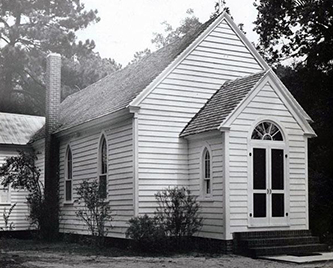Blount, Nathaniel
ca. 1748–1816
Nathaniel Blount, Anglican clergyman, was born in Beaufort County, the third of five sons of Reading Blount. Reared in a family of some means and influence in Eastern Carolina, Blount received sufficient education to study independently for Holy Orders. He was of an introspective and melancholy cast of mind, not a businessman, like many of his numerous Blount relatives, but devoted to religion. In 1773 he sailed to England, where he was ordained deacon on 19 Sept. and priest on 21 Sept. After he returned to America, one of his first acts was to erect a chapel on Chocowinity Creek in Beaufort County, near the present location of Washington. The structure was incorporated into present-day Trinity Church and moved a short distance in 1939 to a site on the Chocowinity-Greenville highway. During the Revolution, he preached frequently by request at patriotic political meetings. After his contract with the vestry of Pitt County was abrogated in the separation of church and state mandated by the state constitution of 1776, he lived almost entirely on the income from property left him by his father in 1776.
 Following the winning of independence, Blount was contacted by the Reverend Charles Pettigrew of Edenton to meet in convention at Tarboro in an attempt to organize the Protestant Episcopal Diocese of North Carolina. Four conventions were held between 1790 and 1794, three of which he attended. At the fourth, he took active part in formulating the procedure for choosing a bishop and in debates on a constitution (which he signed) and served as an elected member of the standing committee. He greatly deplored the fact that Pettigrew, who was elected bishop, never attended a triennial convention to be consecrated. For this and other reasons, the Episcopal church in North Carolina declined steadily until 1817.
Following the winning of independence, Blount was contacted by the Reverend Charles Pettigrew of Edenton to meet in convention at Tarboro in an attempt to organize the Protestant Episcopal Diocese of North Carolina. Four conventions were held between 1790 and 1794, three of which he attended. At the fourth, he took active part in formulating the procedure for choosing a bishop and in debates on a constitution (which he signed) and served as an elected member of the standing committee. He greatly deplored the fact that Pettigrew, who was elected bishop, never attended a triennial convention to be consecrated. For this and other reasons, the Episcopal church in North Carolina declined steadily until 1817.
Blount was an energetic priest, riding great distances on horseback to preach, baptize, hold funerals, and perform marriages. He regularly attended two chapels near him, often visited three others in Beaufort County, and had three other counties on his busy schedule. Usually in poor health, he was nonetheless seldom prevented from trying to reach "poor perishing sinners" and lead them "by Faith, To The Throne of Grace." An advocate of infant baptism, he was bitter toward the Baptists; he disapproved of the Methodist separation from apostolic succession; and he likewise detested Thomas Paine and "his horrid principles."
Some time prior to 1779 he married Ann (maiden name unknown), who died in November 1798. They had at least five surviving children: Selina, Edward, Rebecca, Levi, and James. Blount died in 1816. The exact date and place of burial have, however, vanished from all but tradition.
His underlying strength and devotion to duty kept alive the Episcopal church in his area of the state. In the year of his death, no other Episcopal cleric was resident in North Carolina, and the church appeared dead. In the following year, however, a successful convention was held, which began a revival that Blount had helped to make possible.
References:
Beaufort County Records. Washington, NC.
Lemmon, Sarah McCulloh. "Nathaniel Blount: Last Clergyman of the "Old Church"." The North Carolina Historical Review 50, no. 4 (1973): 351-64. https://www.jstor.org/stable/23529956 (accessed February 21, 2019, access may be restricted to users with accounts).
Lemmon, Sarah McCulloh, ed. The Pettigrew Papers, Vol. 1, 1685–1818. Raleigh: State Department of Archives and History, 1971. https://archive.org/details/pettigrewpapers1971lemm (accessed February 21, 2019).
Additional Resources:
Cheshire, Joseph Blount. Diocese of North Carolina: The Early Conventions: Held at Tawborough, Anno Domini 1790, 1793 and 1794: the First Effort to Organize the Church in North Carolina, Collected from Original Sources and Now First Published. Raleigh: Spirit of the Age Print, 1882. http://digital.lib.ecu.edu/16935 (accessed May 29, 2013).
Harding, Edmund H. "Early Church History Of Washington And The Founding Of St. Peters Parish" in Saint Peters Parish, Washington, North Carolina: A Record of the Century--1822-1922. Charlotte: Queen City Printing Co, 1922. https://digital.lib.ecu.edu/13573 (accessed January 12, 2015).
Haywood, Marshall De Lancey. Lives of the Bishops of North Carolina from the Establishment of the Episcopate in that State Down to the Division of the Diocese. Raleigh: Alfred Williams & Company, 1910. https://archive.org/details/livesofbishopsof00hayw/ (accessed May 29, 2013).
King, Henry T. "Chapter 12" in Sketches of Pitt County, a Brief History of the County, 1704-1910; Illustrations and Maps. Raleigh: Edwards & Broughton Printing Co., 1911. https://archive.org/stream/sketchesofpittco00king#page/n75/mode/2up (accessed May 29, 2013).
North Carolina Highway Historical Marker Program. "B-46: Trinity Church." North Carolina Office of Archives & History. https://www.ncdcr.gov/about/history/division-historical-resources/nc-highway-historical-marker-program/Markers.aspx?sp=Markers&k=Markers&sv=B-46 (accessed May 29, 2013).
Rodman, Lida Tunstall, ed. "Journal of a Tour of North Carolina by William Attmore, 1787" in James Sprunt Historical Publications 17, no. 2 (1922): 25. https://archive.org/stream/journaloftourton00attm#page/24/mode/2up (accessed May 29, 2013).
Image Credits:
"Photograph of Trinity Church in Chocowinity, 1954." Accession no. H.1955.10.1. North Carolina Museum of History, Raleigh, NC. https://collections.ncdcr.gov/RediscoveryProficioPublicSearch/ShowItem.aspx?22494+ (accessed February 21, 2019).
1 January 1979 | Lemmon, Sarah McCulloh